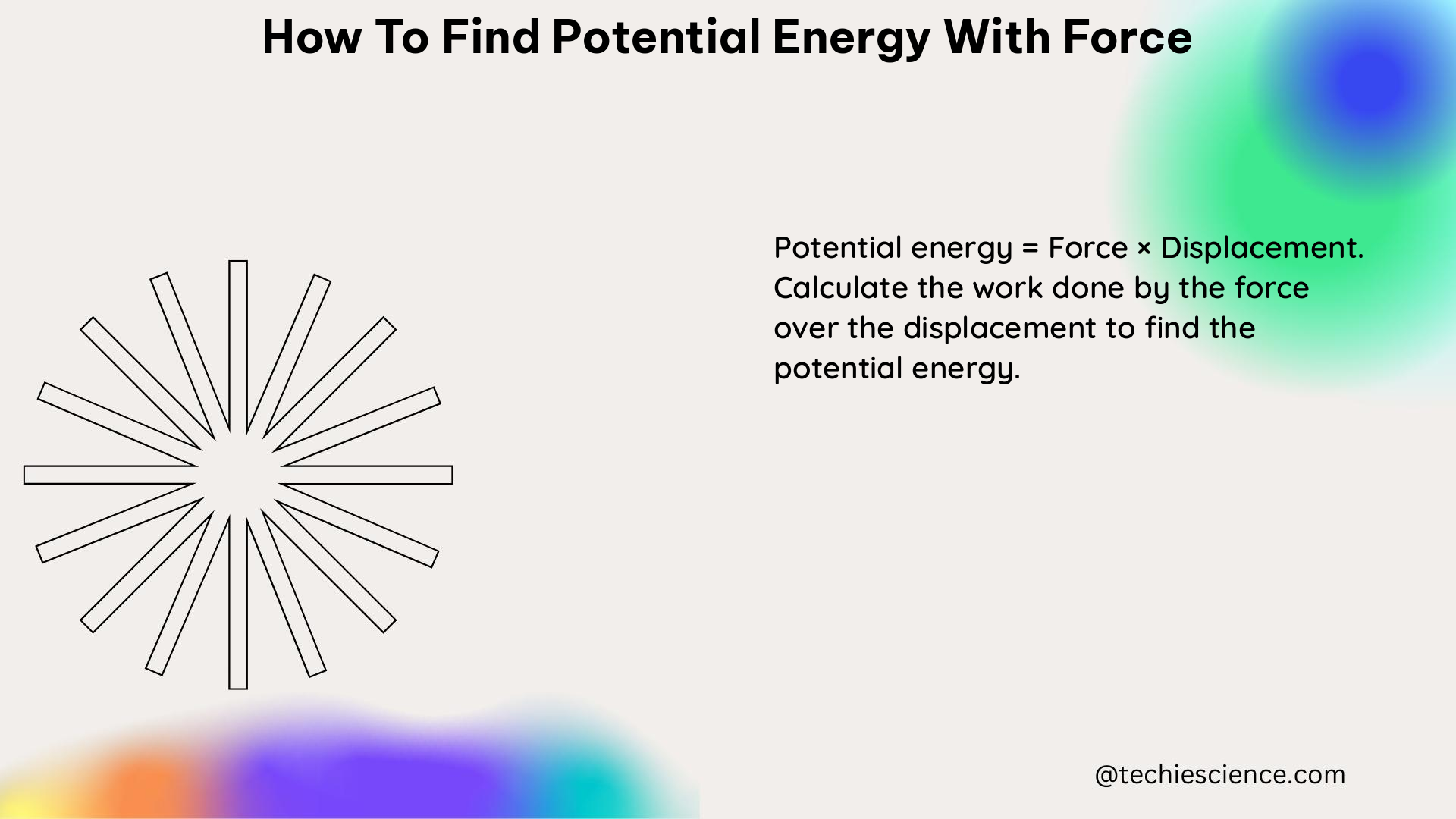Potential energy is a fundamental concept in physics, and understanding its relationship with force is crucial for solving various problems in mechanics. This comprehensive guide will walk you through the step-by-step process of finding potential energy using force, providing you with the necessary theoretical knowledge, formulas, examples, and numerical problems to become a proficient problem-solver.
Understanding the Relationship between Force and Potential Energy
The relationship between force and potential energy is governed by the following fundamental principle:
The force is the negative derivative of the potential energy with respect to position.
Mathematically, this can be expressed as:
F(x) = -dU/dx
where F(x) is the force function, and U(x) is the potential energy function, both as a function of position x.
Graphically, this means that the force is the negative of the slope of the potential energy function at a given point. If the slope is positive, the force is directed to the left, and if the slope is negative, the force is directed to the right.
Calculating Potential Energy from Force

To find the potential energy from the force function, we can integrate the force function with respect to position. The mathematical expression for this is:
U(x) = -∫F(x)dx + C
where C is the constant of integration.
Example: Potential Energy of a Spring-Mass System
Consider a spring-mass system, where the force exerted by the spring is given by Hooke’s law:
F(x) = -kx
where k is the spring constant, and x is the displacement from the equilibrium position.
To find the potential energy of the spring, we can integrate the force function:
U(x) = -∫F(x)dx + C
= -∫(-kx)dx + C
= (1/2)kx^2 + C
where C is the constant of integration.
The potential energy of the spring-mass system is then given by:
U(x) = (1/2)kx^2 + C
Numerical Example
Suppose the potential energy of a system is given by the function:
U(x) = (1/2)kx^2
where k = 50 N/m.
Find the potential energy at x = 3 m.
Solution:
Substituting the given values into the potential energy function, we get:
U(3 m) = (1/2)k(3 m)^2
= (1/2)(50 N/m)(3 m)^2
= (1/2)(450 N·m)
= 225 N·m
Therefore, the potential energy of the system at x = 3 m is 225 N·m.
Calculating Force from Potential Energy
If you know the potential energy function U(x), you can find the force function F(x) by taking the negative derivative of the potential energy with respect to position:
F(x) = -dU/dx
This process is known as “calculating force from potential energy.”
Example: Force of a Spring-Mass System
Recall the potential energy function for a spring-mass system:
U(x) = (1/2)kx^2 + C
To find the force function, we take the negative derivative of the potential energy with respect to position:
F(x) = -dU/dx
= -(d/dx)(1/2)kx^2
= -kx
Therefore, the force function for the spring-mass system is F(x) = -kx, which is the same as Hooke’s law.
Numerical Example
Suppose the potential energy of a system is given by the function:
U(x) = (1/2)kx^2
where k = 20 N/m.
Find the force at x = 2 m.
Solution:
To find the force, we take the negative derivative of the potential energy function:
F(x) = -dU/dx
= -(d/dx)(1/2)kx^2
= -kx
= -(20 N/m)(2 m)
= -40 N
Therefore, the force at x = 2 m is -40 N, directed to the left.
Advanced Concepts and Applications
-
Conservative and Non-Conservative Forces: In conservative force fields, the work done by the force is path-independent, and the potential energy function can be defined. In non-conservative force fields, the work done by the force is path-dependent, and the potential energy function cannot be defined.
-
Potential Energy Diagrams: Potential energy diagrams are graphical representations of the potential energy function, which can provide valuable insights into the behavior of a system. These diagrams can be used to analyze the stability of equilibrium points, the direction of the force, and the work done by the force.
-
Potential Energy and Mechanical Energy: Potential energy is one component of the total mechanical energy of a system, which also includes kinetic energy. The conservation of mechanical energy is a fundamental principle in physics, and it can be used to solve a wide range of problems.
-
Applications in Various Fields: The concepts of force and potential energy are widely used in various fields, such as classical mechanics, quantum mechanics, electromagnetism, and astrophysics. Understanding these concepts is crucial for solving problems in these domains.
Conclusion
In this comprehensive guide, we have explored the fundamental relationship between force and potential energy, and we have provided step-by-step instructions, formulas, examples, and numerical problems to help you master the art of finding potential energy using force. By understanding these concepts and applying the techniques presented in this guide, you will be well-equipped to tackle a wide range of physics problems and deepen your understanding of the underlying principles of the physical world.
Reference:
- Phys. LibreTexts. 2.5: Force and Potential Energy. Retrieved from https://phys.libretexts.org/Under_Construction/Purgatory/2:_Applying_Models_to_Mechanical_Phenomena/2.5:_Force_and_Potential_Energy
- OpenStax. Work & Mechanical Energy. Retrieved from https://opentextbc.ca/foundationsofphysics/chapter/work-mechanical-energy/
- YouTube. Calculating Force From Potential Energy. Retrieved from https://www.youtube.com/watch?v=mYMZ66hMO3Y

The lambdageeks.com Core SME Team is a group of experienced subject matter experts from diverse scientific and technical fields including Physics, Chemistry, Technology,Electronics & Electrical Engineering, Automotive, Mechanical Engineering. Our team collaborates to create high-quality, well-researched articles on a wide range of science and technology topics for the lambdageeks.com website.
All Our Senior SME are having more than 7 Years of experience in the respective fields . They are either Working Industry Professionals or assocaited With different Universities. Refer Our Authors Page to get to know About our Core SMEs.